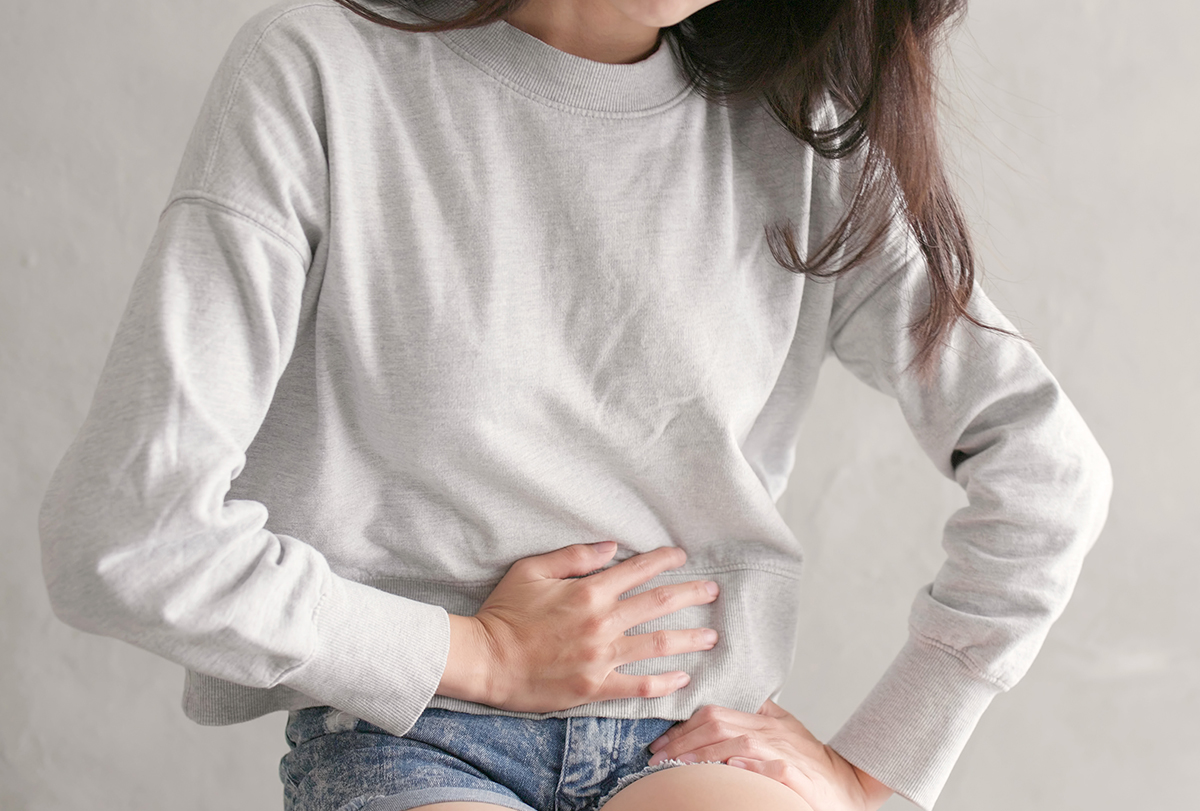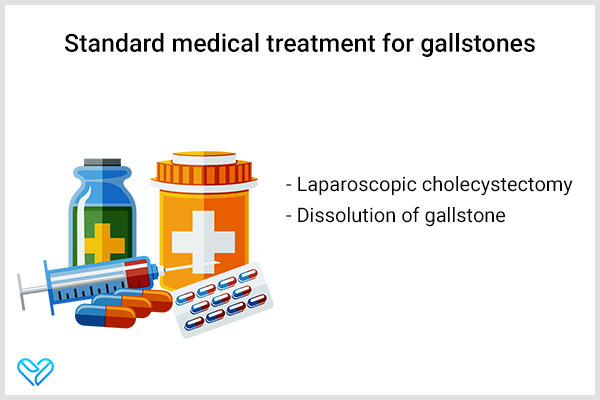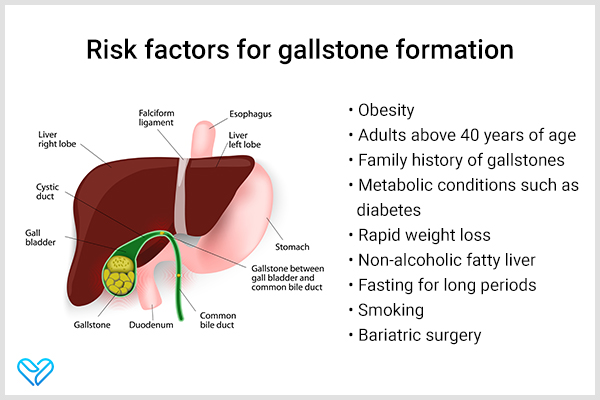In this article:
Bile is a green, yellow, or brownish liquid secreted by the liver and plays a critical role in the digestive process. Its primary function is to break down fats so that they can be easily absorbed by the body.

The bile produced in the liver is transferred into a small hollow pouch underneath it called the gallbladder. The gallbladder stores this digestive fluid and releases it into the small intestine during digestion. (1)
Nearly 500–600 mL of bile gets secreted by the liver daily. (2)
Bile is made up of bile salts, cholesterol, conjugated bilirubin, phospholipids, electrolytes, and water. Certain imbalances in the normal composition of bile can make it clump and harden, forming stone-like deposits within the gallbladder known as gallstones.
Medically known as cholelithiasis, gallstone formation is a fairly common condition that affects nearly 20 million people in the United States. The size of a gallstone can range from a grain of sand to a pebble to as large as a golf ball. (1)
Types of Gallstones
There are three types of gallstones commonly found in patients:
- Cholesterol gallstones are the most common form of gallstones and are mostly (at least 90%) composed of excess cholesterol deposits. More than 85% of gallstones diagnosed in the West are cholesterol stones.
- Bilirubinate gallstones or pigment stones contain at least 90% bilirubin, are brown or black in color, and mostly affect people suffering from liver diseases such as cirrhosis or chronic hemolysis. Certain factors can speed up gallstone formation such as alcoholic liver disease, chronic hemolysis, and advanced age.
- Mixed-composition gallstones comprise cholesterol, bilirubin, and other materials such as calcium in varying proportions. (1)
What Causes Gallstones?

Gallstones are largely the result of:
- Excess cholesterol in the bile
- Excess bilirubin in the bile
- Lack of bile salts in the bile
- Inability of the gallbladder to empty itself completely or frequently enough (3)
The exact reason for such changes in the composition of bile is not clearly understood.
Symptoms of Gallstones
Almost 80% of the people who develop gallstones do not present any symptoms for years. It is when the stone gets lodged in the duct that drains bile out of the gallbladder that the following symptoms may develop:
- Sudden and severe abdominal pain, mostly in the upper-right area where the gallbladder is located, from which it may radiate to other areas such as the chest and shoulder. Initially, the pain may come and go, lasting from half an hour to several hours at a time. It’s best to consult your doctor if the pain lasts for more than 2 hours or progressively worsens.
- Increased amount of flatulence or gas buildup in the abdominal region, causing frequent belching
- Nausea and vomiting
- Loss of appetite
- Rapid weight loss
- Symptoms of jaundice such as pale or yellowish skin (4)
- Bloating
- Clay-colored or pale stools
- Chest pain
- Fever
Gallstones gradually increase in size at the rate of 1–2 mm every year and can take anywhere between 5 and 20 years to grow big enough to cause blockages in the ducts and cause symptoms. They mostly form within the gallbladder, but they can move inside the cystic duct or common bile duct to obstruct the flow of bile.
The blocked duct causes a buildup of bile inside the gallbladder, triggering pain and inflammation in the abdomen, called biliary colic, which is the most common symptom of gallstones.
The term colic is used to describe a particular kind of pain that tends to come and go. In the case of biliary colic, the pain usually has a sudden onset after a heavy, fatty meal, becomes progressively worse over the next 15 minutes to an hour, and then remains at the same intensity for the next 6–12 hours before slowly subsiding in the following hour or two with only a dull ache left behind.
Biliary colic typically begins in the upper quadrant of the abdomen, where it may spread to the surrounding areas and even radiate to the back or down the arm. It is generally severe enough to warrant a visit to the emergency room.
Patients may also experience nausea, vomiting, and epigastric tenderness, but the presence of fever indicates cholecystitis, which often requires hospitalization. Once the biliary colic resolves, you will feel absolutely fine and have no symptoms until the next flare-up. (5)
Biliary colic in and of itself is not proof of gallstones, since other gastrointestinal conditions can trigger it as well. However, acute cholecystitis and pancreatitis are the prime suspects if this pain persists for more than 12 hours, more so if it is accompanied by vomiting or fever. (5)
Standard Medical Treatment for Gallstones

Doctors generally use the following interventions to get rid of gallstones:
1. Laparoscopic cholecystectomy
The most preferred treatment for this condition is a keyhole surgery known as laparoscopic cholecystectomy, wherein the surgeon makes a small abdominal incision and inserts a lighted tube called a laparoscope through it to remove the gallbladder.
It is possible to live a normal life without the gallbladder as your liver will continue making bile. (6)
2. Dissolution of gallstone
If surgery is not possible or the stones are too small, are full of cholesterol, and present mild symptoms, the doctor will most probably prescribe certain oral medications that contain bile acids such as ursodiol (Actigall), ursodeoxycholic, and chenodiol (Chenix) to break up the gallstones.
This noninvasive treatment is most effective for dissolving small cholesterol stones. It can successfully eliminate 40%–80% of the stones but will take 6–12 months or longer to deliver results.
Surgery can be quite risky for geriatric patients as well as those who suffer from concomitant medical disorders. In such cases, ingesting bile acids orally for many months is the preferred option. (7)
Diagnosing Gallstones
Gallstones can go undetected for a long time since most patients remain asymptomatic for years. In such cases, no treatment is needed, and the stones may dissolve or pass out of the body on their own.
However, if you do experience any of the above-listed symptoms, visit a physician, who will use the following diagnostic tools to look for the presence of gallstones:
- Ultrasound tests: Abdominal or endoscopic ultrasounds are performed to look for gallstones in the gallbladder.
- CT or MRI scans: Rarely, you may be asked to undergo an MRI scan if the ultrasound is unable to detect stones.
- Blood tests: Some blood tests may be done to diagnose jaundice or pancreatitis.
- Cholescintigraphy: Also known as hydroxyl iminodiacetic acid (HIDA) scan or hepatobiliary scan, this imaging test is used to get an inside view of the biliary tract.
- Endoscopic retrograde cholangiopancreatogram (ERCP): This test clubs the techniques of upper gastroendoscopy and X-rays to detect problems in the bile and pancreatic ducts. (8)
Risk Factors for Gallstone Formation
A few factors that can make you more susceptible to developing gallstones are: (9)(10)

- Pregnancy – It causes an increase in progesterone, which may lead to decreased contractility of the gallbladder. This can put the gallbladder at risk of stasis or inactivity. Thus, women who have previously given birth tend to be at higher risk of cholelithiasis. (11)
- Obesity
- Adults above 40 years of age
- Family history of gallstones
- Certain medicines such as estrogens, fibrates, and somatostatin analogs
- Metabolic conditions such as diabetes
- Female gender – About 20% of American women at the age of 60 and women between the ages of 20 and 60 years are more susceptible to the condition than men.
- Rapid weight loss
- Nonalcoholic fatty liver
- Fasting for long periods
- Smoking
- Bariatric surgery
- Digestive issues such as Crohn’s disease and ileal resection
Prevention of Gallstones
Here are some things you can do to reduce the risk of gallstone formation:
- Adopt a healthy diet that includes a lot of dietary fiber, healthy fats, antioxidants, and fish while cutting down on unhealthy fats, salt, sugar, refined carbs and grains, red meat, dairy, and alcohol.
- Quit smoking.
- Maintain optimum fluid intake.
- Maintain a healthy body weight.
- Stay active and exercise regularly.
- Manage metabolic conditions.
- Control all factors influencing glycolipid metabolism. (12)
When to See a Doctor
Seek medical help if you develop any of the following symptoms:
- High fever with chills
- Severe or persistent abdominal pain, especially in the upper-right area
- Yellowing of the skin and the whites of the eyes (jaundice)
- Vomiting
Final Word
Gallstones can go without treatment as long as they do not present any symptoms, and they may even dissolve on their own. But if you develop any of the characteristic symptoms of this condition, it is important to seek proper medical diagnosis and treatment to avoid complications.
 Continue Reading8 Home Remedies for Gallstones and How to Use Them
Continue Reading8 Home Remedies for Gallstones and How to Use Them
- Was this article helpful?
- YES, THANKS!NOT REALLY


